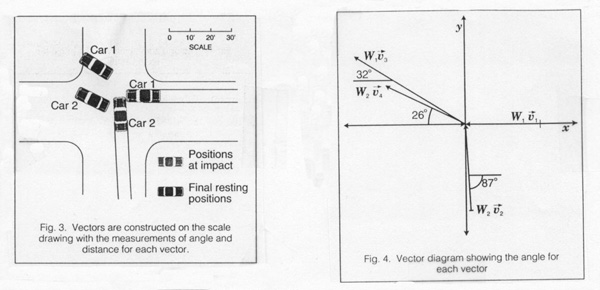Trigonometry and vectors are used in helping to determine
the speeds of automobiles in a car accident. A quantity that
plays a central role in accident reconstruction is the
coefficient of friction, f, which is defined by the
equation  ,
where F is the
force (a vector) and W is the weight. When a driver slams
on the brakes and the car skids to a stop, its minimum speed
can be estimated by using the formula
,
where F is the
force (a vector) and W is the weight. When a driver slams
on the brakes and the car skids to a stop, its minimum speed
can be estimated by using the formula
 , where S is the
speed of the car in miles per hour, f is the drag factor or
coefficient of friction, and d is the length of the skid marks
measured in feet.
, where S is the
speed of the car in miles per hour, f is the drag factor or
coefficient of friction, and d is the length of the skid marks
measured in feet.
How fast was a car going which skidded 70 feet on dry brick (coefficient of friction is .7 for dry brick)? ______________
How fast was a car going which skidded 40 feet on wet oiled
gravel (drag factor is .4 for wet oiled gravel)? ______________
Check your answers with the nomograph from AAA.
Conservation of Momentum:
Linear momentum is the product of mass and velocity. By applying
the law of conservation of linear momentum, we can obtain a
vector equation that will serve as a means of
determining unknown speeds for two vehicles in a collision.
The total momentum before the collision of the vehicles is equal to
the total momentum after the collision. The corresponding vector
equation is
 ,
,
where M1 and M2 represent the masses of car 1 and car 2, respectively, with v1 and v2 the corresponding velocities before impact and v3 and v4 the velocities after the collision.
We know that  , where M
denotes mass, W denotes weight, and g denotes gravity
(32 feet per second per second).
, where M
denotes mass, W denotes weight, and g denotes gravity
(32 feet per second per second).
So, the equation above can be written as:
 ,
,
where W1 and W2 are the respective
weights of the two vehicles involved. The resultant vector (figure 1)
obtained by adding  ,
can be broken down into the horizontal and vertical components
,
can be broken down into the horizontal and vertical components
 , and
___________________________, respectively, where
, and
___________________________, respectively, where
 and
and
 represent the directions of vectors v3 and
v4. By using the formula for the conservation
of linear momentum and taking the magnitudes of vertical and horizontal
components, we obtain
represent the directions of vectors v3 and
v4. By using the formula for the conservation
of linear momentum and taking the magnitudes of vertical and horizontal
components, we obtain
 ,
,
and
 ,
,
with
 and
and
 being the directions for
vectors v1 and v2.
being the directions for
vectors v1 and v2.

Police officers make a scale drawing of the accident scene and measure skid marks in accidents where loss of life occurs or where substantial damage occurs. An accident is illustrated in figure 2. Let the x-axis be the path of approach to impact of car 1. We locate the center of mass of each car as the point of intersection of the lines joining each front tire to its diagonally opposite rear tire. For each car, the vector from center of mass at impact to the center of mass at final resting position is drawn and measured to determine the distance and angle.

In figure 4, we have these vectors,
 , and
, and
 positioned at the origin and illustrating the paths of the
two vehicles after impact. These vectors are 25.5 feet and 16.75
feet, respectively. If we take the drag factor at the time of
impact to be f = 0.83, then
positioned at the origin and illustrating the paths of the
two vehicles after impact. These vectors are 25.5 feet and 16.75
feet, respectively. If we take the drag factor at the time of
impact to be f = 0.83, then
magnitude of v3 = _____________ and
magnitude of v4 = _____________ .
We note that the vectors v1, v2,
v3, and v4 have directions,
measured from the positive x-axis, of
180 ,
93
,
93 ,
148
,
148 , and
154
, and
154 , respectively. Letting
W1 and W2 be 4,220 and 3,875
pounds, respectively, and using the previous values for the magnitudes
of vectors v3 and v4,
substitute into
, respectively. Letting
W1 and W2 be 4,220 and 3,875
pounds, respectively, and using the previous values for the magnitudes
of vectors v3 and v4,
substitute into
 .
.
We obtain  ,
,
so the magnitude of vector v2 = ___________________.
Then substitute this value into

to obtain the magnitude of
vector v1 = ___________________.
These are the speeds right before impact. By substituting into the
Combined-Speed formula,
 ,
,
(where Sf is the final speed and S0 is
the initial speed) we get the result that our drivers were travelling
at 48 mph and 37 mph the split second before they slammed on their brakes.